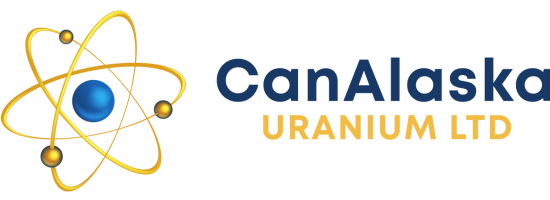Vancouver, Canada, May 9th, 2008 – CanAlaska Uranium Ltd. (CVV-TSX.V) (the “Company”) is pleased to announce that its winter drill programs at Cree Lake and Lake Athabasca and Key Lake Projects have now concluded. All samples for assay and trace element geochemistry are now at the laboratories and we awaiting analyses. The geochemical signatures of the intense alteration zones seen in drill cores at both the Cree Lake and Lake Athabasca projects are expected to detail the halo effect of uranium mineralization, as both programs found (small) localized zones of elevated uranium counts associated with hematite oxidation and zones of hydrothermal fluid flow.
These first drill intersects are highly encouraging evidence of hydrothermal mineralizing systems coinciding with the airborne geophysical anomalies. The target areas are moderately large (500m – 1 km) in size, but are at shallow depths and well-capable of being fence-drilled to locate the central mineralizing zones.
The successful winter exploration program will now be followed with additional drilling, and summer technical and physical work programs. Preparations for the summer exploration season are already underway, with field crews preparing equipment, camp supplies and undergoing safety training. Field work will commence in early June, 2008, immediately after ice-breakup.
Cree Lake Project Drilling Intersects Major Hydrothermal System and Clays

Exploration budgets for summer drilling at Cree Lake have now been delivered to the Company’s partners at the Korean Consortium. On this property, only two of the seven central exploration targets were tested by drilling during the winter. On both targets, the drill holes intersected near-surface hydrothermal systems with intense clay alteration which, in places, exhibited complete disaggregation of the sandstone into sandy illitic clays. (See Photos #1 and #2 for comparisons, and Photos #3 and #4 for images of the fluid and altered clay and sands).


The first of the targets drilled at Cree Lake was on land, and this, as well as four other zones, are being prepared for further drilling. The second target at Cree Lake was covered by shallow water, making it amenable to further geophysical mapping, as well as marine seismic surveying during the summer. This is a very significant target, as a step-out hole 100 metres from the main zone of alteration showed moderate alteration throughout the sandstone column, increased radioactivity in the lake bottom clays, and a zone of hematite alteration with radioactivity counts up to 250 cps in the underlying basement rocks.
Four attempts were made to drill the central portion of the target, but only two holes were successful in reaching the unconformity. These holes exhibited extensive hydrothermal alteration in the top portion of the hole to 88 m and 93m, following which there was core loss in broken, fractured ground in several locations down to 122 m and 125 m.
Both of these holes also showed slight increase in radioactivity near the unconformity and in the basement. Both targets drilled on the Cree East Project have confirmed the geophysical anomalies with strong alteration at shallow depth.
The alteration did not persist to the unconformity, indicating an inclined structure, but slight increase in radioactivity near and below the unconformity was observed in all three holes completed into the basement.


Lake Athabasca Drilling Reveals Intrusive and Unconformity Targets

The Lake Athabasca Project is located along the northern edge of the Athabasca Basin, south of the Uranium City area. A six week drill program was carried out in proximity to Johnston Island from February to April, 2008 to test a series of geophysical targets characteristic of intrusive-style and structurally-controlled unconformity uranium mineralization. Four of the seven original targets were tested. All showed some zones of interesting alteration normally associated with uranium deposits in the area. However, the best target has provided further evidence to support detailed summer seismic surveys and further drilling. Target “E”, located 1.4 km south of Stewart Island, intersected the unconformity at 106m, some 200m shallower than expected from the geophysical survey (See Figure #1).

Based on this unconformity depth, the geophysical data has been re-interpreted as a horst-like uplift along a major E-W fault structure, instead of a sandstone-hosted alteration halo. Strong silicification and dravite alteration have been observed along strike of the structure on the shore of Grouse Island.
A parallel fault has been interpreted to exist in the vicinity of the Stewart Island uranium showing, drilled by the Company in 2006. Both of these drill-holes intersected hematised basement, but one hole included a 3 metre broken, strongly fractured core, 50 metres below the unconformity.
Work over the summer with seismic survey equipment will concentrate on following the edges of the block and the controlling fault structures, as it is thought that these are the most likely locations for uranium mineralization in this area.
Surface mapping and drill target location will continue on land to investigate areas of the Gunnar granite, the host to the Gunnar Uranium Mine, where high radioactivity and altered granite were observed in 2007. The winter drilling only targeted one of these zones, and was too limited in extent to drill across the full width of the large alteration halo. Drill holes LAA008 and LAA010, located 200 metres apart, exhibited brecciated and silicified granites and amphibolite with extensive alteration and sulphides, but only back ground uranium counts (30-100 cps). Further step-out drilling is required to enter the zone(s) of interest.
Key Lake Project
Winter drilling on the Key Lake project intersected hydrothermal alteration and hematization within a structure located 10 km south-west of the Key Lake Mine. Elevated radiometric counts detected by hand scintillometer and down-hole probe in drill hole KEY005 were due to thorium mineralization, and not uranium mineralization. Further drilling, which will concentrate on a previously drilled target located on a claim 8 km to the NW where drilling in 2006 intersected a wide structural corridor with 0.06% U3O8 over 0.15 m in drill hole KEY001, is being discussed with Westcan Uranium Ltd., the optionee of the project.
The Qualified Person for this news release is Mr. Peter Dasler, P. Geo.
About CanAlaska Uranium Ltd. — www.canalaska.com
CANALASKA URANIUM LTD. (CVV — TSX.V, CVVUF — OTCBB, DH7 — Frankfurt) is undertaking uranium exploration in eighteen 100%-owned and two optioned uranium projects in Canada’s Athabasca Basin. Since September 2004, the Company has aggressively acquired one of the largest land positions in the region, comprising over 2,500,000 acres (10,117 sq. km or 3,906 sq. miles). CanAlaska has expended over Cdn$40 million exploring its properties and has delineated multiple uranium targets. The Company’s high profile in the prominent Athabasca Basin has attracted the attention of major international strategic partners. Among others, Mitsubishi Development Pty., a subsidiary of Japanese conglomerate Mitsubishi Corporation, has undertaken to provide CanAlaska C$11 mil. in exploration funding to earn 50% of the West McArthur Project. In addition, exploration of CanAlaska’s Cree East Project has commenced under a C$19 mil. agreement executed with a consortium of Korean companies led by Hanwha Corporation, and comprising Korea Electric Power Corp., Korea Resources Corp. and SK Energy Co, Ltd.
On behalf of the Board of Directors
“Peter Dasler”
Peter Dasler, P. Geo., President & CEO
Investor Contact: Emil Fung, Vice President, Corporate Development
Tel: +1.604.688.3211 Toll Free (North America) 1-800-667-1870 Email: info@canalaska.com
The TSX Venture has not reviewed and does not accept responsibility for the adequacy or accuracy of this release: CUSIP#13708P 10 2.
This news release contains certain “Forward-Looking Statements” within the meaning of Section 21E of the United States Securities Exchange Act of 1934, as amended. All statements, other than statements of historical fact, included herein are forward-looking statements that involve various risks and uncertainties. There can be no assurance that such statements will prove to be accurate, and actual results and future events could differ materially from those anticipated in such statements. Important factors that could cause actual results to differ materially from the Company’s expectations are disclosed in the Company’s documents filed from time to time with the British Columbia Securities Commission and the United States Securities & Exchange Commission. Not to be construed as an offer to buy or sell securities of CanAlaska Uranium Ltd.

